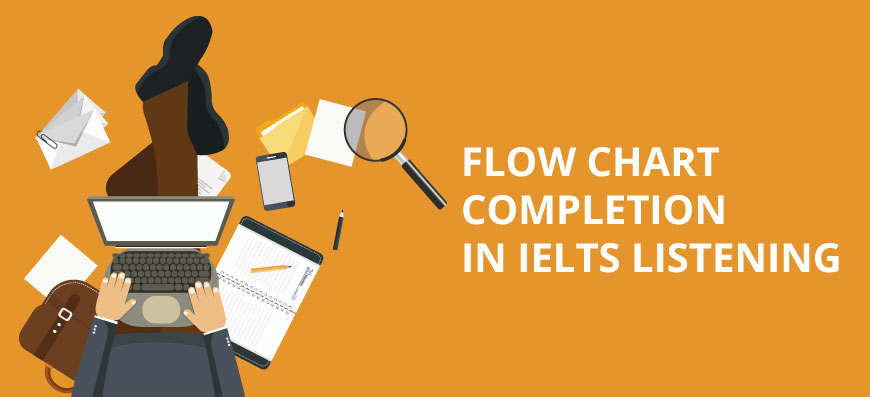Tackle Flow-Chart Completion In IELTS Listening Without Breaking A Sweat.

So you think you are prepared for IELTS listening with adequate skills in English and grammar. Truth be told, a lot of students commit mistakes in IELTS Listening not because of their weak grammar or communication skills. The culprit is often half knowledge on what to expect. Expecting the unexpected adds pressure leading to unforced errors.
If you are also one of those walking blind and just hoping that your IELTS Listening test may go down well, it is time to raise a red flag. Knowing the question 'types' that you may encounter is common advice which I am sure you may have heard already from various sources. Of course, knowing the question types you are likely to encounter is absolute gold flakes but so is practicing each of such question types.
Don't just KNOW the question types, EXPERIENCE them.
What many so-called advisors and IELTS experts don't tell you is that knowing the question types is simply not enough. Experience each such question type when training is the only way to handle the tough and the tricky ones. Flow-chart completion is one such question type that often makes students feel jittery. Don't let the multiple square boxes and the directional flow arrows make you lose track. Here are some tips to ensure Flow-chart completion questions would not hold a challenge in your quest to score high in IELTS Listening.
Effective tips to encounter the dreaded flow chart completion
A Flow chart does not always mean a technical analysis.
Many students often equate a flow chart question type with technical analysis. While flow charts have been used extensively in computer science and technical subjects, a flow chart question does not always mean technical analysis. At the core of it, a flow chart represents information flow. Just like a story in the movies or chapters in books, the flowchart represents an information flow.
Think in terms of hierarchy when listening to the conversation or monologue.
Apt handling of flow chart question type starts as you listen to the conversation. Break down the conversation into a hierarchy system. A conversation always has a connection or flow of information. Connect the dots mentally as you listen to the conversation. For example, the two people conversing are unlikely to converse of a different subject all together suddenly. Whenever there is a new topic introduced in the conversation, make a mental note. This may mean the information is flowing from the previous block to the new one in some way.
Practice Flowcharts questions.
Do not worry if making a mental note, connecting the dots or following the hierarchy sound difficult for now. Practice some flowchart questions and you will know how to make the note of the conversational flow. Majority of IELTS Listening sample tests offer flow chart questions to ensure you are confident of approaching it on test day. Check out our wide range of IELTS Listening sample tests to ensure you are getting apt practice to understand how flow chart questions operate. Once you understand the information flow, flow chart questions will not have any power to break you into a sweat.
If you are also one of those walking blind and just hoping that your IELTS Listening test may go down well, it is time to raise a red flag. Knowing the question 'types' that you may encounter is common advice which I am sure you may have heard already from various sources. Of course, knowing the question types you are likely to encounter is absolute gold flakes but so is practicing each of such question types.
Don't just KNOW the question types, EXPERIENCE them.
What many so-called advisors and IELTS experts don't tell you is that knowing the question types is simply not enough. Experience each such question type when training is the only way to handle the tough and the tricky ones. Flow-chart completion is one such question type that often makes students feel jittery. Don't let the multiple square boxes and the directional flow arrows make you lose track. Here are some tips to ensure Flow-chart completion questions would not hold a challenge in your quest to score high in IELTS Listening.
Effective tips to encounter the dreaded flow chart completion
A Flow chart does not always mean a technical analysis.
Many students often equate a flow chart question type with technical analysis. While flow charts have been used extensively in computer science and technical subjects, a flow chart question does not always mean technical analysis. At the core of it, a flow chart represents information flow. Just like a story in the movies or chapters in books, the flowchart represents an information flow.
Think in terms of hierarchy when listening to the conversation or monologue.
Apt handling of flow chart question type starts as you listen to the conversation. Break down the conversation into a hierarchy system. A conversation always has a connection or flow of information. Connect the dots mentally as you listen to the conversation. For example, the two people conversing are unlikely to converse of a different subject all together suddenly. Whenever there is a new topic introduced in the conversation, make a mental note. This may mean the information is flowing from the previous block to the new one in some way.
Practice Flowcharts questions.
Do not worry if making a mental note, connecting the dots or following the hierarchy sound difficult for now. Practice some flowchart questions and you will know how to make the note of the conversational flow. Majority of IELTS Listening sample tests offer flow chart questions to ensure you are confident of approaching it on test day. Check out our wide range of IELTS Listening sample tests to ensure you are getting apt practice to understand how flow chart questions operate. Once you understand the information flow, flow chart questions will not have any power to break you into a sweat.
Posted
September 14, 2019





